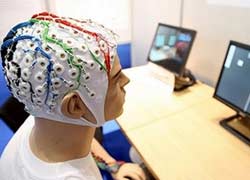Your wishes, orders to the computer
A fanciful dream of using thought to control things is now within human reach, thanks to two research works on computer-brain interface technology about to be published in a magazine. Nature language.
 Source: AFP According to the authors, thanks to the revolutionary advances of neuronal simulator, patients with brain or spinal injury can still move, interact, and control things. object.
Source: AFP According to the authors, thanks to the revolutionary advances of neuronal simulator, patients with brain or spinal injury can still move, interact, and control things. object.
In the first study of Massachussetts General Hospital (MGH), a 25-year-old patient paralyzed after a spinal cord injury three years ago was able to open the email, turn on the TV and open / close an artificial arm - all by imaginary movements
The part of the patient's brain commanding the experiment was wired with 96 points of micro sensor types. Each of the patients' thoughts will produce millions of nerve signals rushing to the micro sensor points. They will be captured, decoded and processed by the computer, and eventually, "translated" into control commands.
" We found that even after having suffered multiple spinal cord injuries for years, signals of limb movement are still available and usable ," Dr. Hochberg, head of the MGH team, said. .
Although the idea of BrainGate Neural Interface System is not too new, it is really the most encouraging and satisfactory result so far.
In the second study on her two monkeys, two experts, Krishna Shenoy and Gopal Santhanam of Stanford University, found that they could speed up the signaling process with a device to simulate nerve movement, allowing disease. Paralyzed personnel communicate at speeds of up to 15 words per second.
However, it is hard to expect these advanced technologies to become universally popular overnight. Scott warned that there are still many "important issues to overcome", most notably "wireless" of emulator devices to minimize the risk of infection for users.
Thien Y
- The decoding machine in the World works again
- Dell started shipping Vista computers
- Robot performs human commands
- 3 benefits of restarting the computer
- Computer cum comedian
- The new, nearly invisible spy can be located right in your computer chip
- Computer spontaneously explodes when hacked
- How dirty is your computer?
- IBM is about to launch a smaller computer than a grain of salt
- Revealing the computer with a small angle of rice
- 3D computer 'embedded' the user's hands into the screen
- Shut Down Expert: Professional startup and shutdown
 What is the Snapdragon SiP chip?
What is the Snapdragon SiP chip? How to create a yellow circle around the mouse cursor on Windows
How to create a yellow circle around the mouse cursor on Windows Edit the Boot.ini file in Windows XP
Edit the Boot.ini file in Windows XP 3 ways to restart the remote computer via the Internet
3 ways to restart the remote computer via the Internet